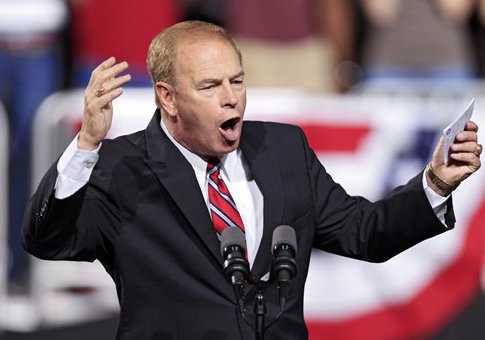The Ohio Environmental Protection Agency under former governor Ted Strickland flagged the official at the heart of the current water contamination crisis in Sebring for negligence and false reporting back in 2009 but allowed him to continue working at the agency despite serious misdeeds.
Strickland, now a Democratic candidate for U.S. Senate in the Ohio, presided over the state agency when it faulted James Bates, the Sebring water superintendent, for submitting false reports and endangering public health, according to an official document obtained by the Washington Free Beacon. Strickland’s EPA punished Bates, who is now under criminal investigation for possibly falsifying reports, by not allowing him to obtain a higher professional certification.
The August 2009 document lays out Bates’ multiple violations of the Ohio Revised Code Chapter 6109, which dictates rules for safe drinking water, and the Ohio Administrative Code. The findings and orders were issued by Chris Korleski, then-director of the Ohio EPA.
As operator of record for the Sebring and Malvern water systems, Bates installed unapproved water systems, maintained faulty records, and deliberately collected water samples that did not accurately represent the condition of the public water systems, in addition to other violations, according to the EPA’s findings.
He did not perform his job responsibly or competently, and several of his actions "constitute[d] the knowing or negligent submission of misleading, inaccurate, or false reports," the EPA document read.
"Respondent’s actions documented in these finding demonstrate a pattern of operation which may constitute operation in a manner endangering the public health or welfare," the director concluded.
Strickland’s EPA ordered Bates to immediately withdraw his application for a Class IV water supply certification. Bates already possessed a Class III certificate, which allowed him to continue to perform his duties in Sebring until last month, when the EPA revoked his license after tap water at seven homes in Sebring was found to have elevated levels of lead and copper.
The EPA has also opened a criminal investigation into Bates, accusing him of not performing his job correctly and possibly falsifying reports.
Attempts to reach Bates for comment were unsuccessful. He told the Associated Press last month that the allegations surrounding the Sebring crisis were an "outright lie" and that he had not falsified reports.
The Sebring crisis, which forced the local government to shut down schools and advise children and pregnant women against drinking the town’s lead-contaminated water, has sparked national outcry along with the crisis in Flint, Michigan. Strickland expressed outrage at the government’s failure to protect Sebring’s water from contamination.
"What happened in Sebring, Ohio, should not be happening in America. No one in any community should ever fear that when they turn on their faucet, mix formula for their baby, or take a shower that the water coming out of the spigot is not safe," Strickland wrote in a Medium post last week.
"Access to clean water is a necessity for our communities and protecting the safety of our water is a central duty of our government. I share the justifiable anger that the citizens of Sebring are feeling about the gross failure of this responsibility."
Strickland, who served as Ohio’s governor from 2007 to 2011, presided over an EPA that spent substantially less money on drinking water protection in fiscal years 2010 and 2011 than in previous years. In the executive budget for 2010, Strickland cut funds for drinking water protection by $128,000.
In 2010 and 2011, Strickland’s EPA spent $5.6 million and $5.8 million on drinking water protection. The state dollars spent to protect Ohio’s drinking water in 2007, 2008, and 2009 totaled $7.4 million, $7.0 million, and $7.6 million, respectively.
Overall, Strickland’s EPA spent $16 million less protecting Ohio’s environment his final year in office than it did his first year as governor.
Strickland’s campaign has used the Sebring crisis to attack incumbent Sen. Rob Portman (R., Ohio), who the former governor will likely compete against in the general election for the Senate seat. Strickland’s campaign spokesman slammed Portman last week for voting against legislation that would have helped Flint, Sebring, and other locations with water safety problems.
Portman is currently cosponsoring legislation that would boost water safety and address the lead crisis. The amendment, which resulted from negotiations between Portman negotiated and Sen. Debbie Stabenow (D., Mich.) last week, would send resources to any state to address the lead poisoning crisis and would require the EPA to notify the public within 15 days if toxic levels of lead are detected in public water systems.
A representative for the Strickland campaign did not respond to a request for comment.
